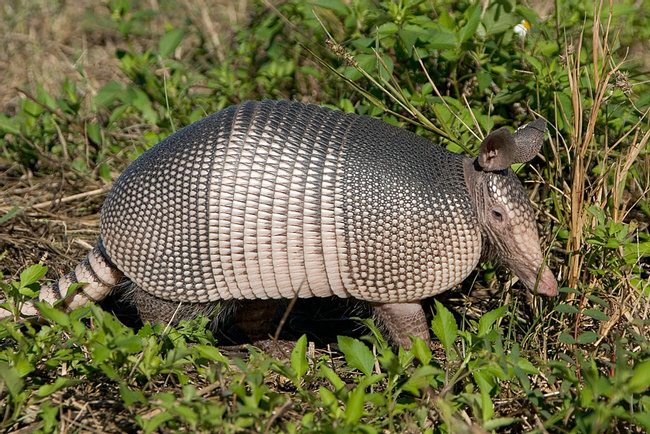
More about Armadillo
Habitat
This species of armadillo can survive in many different types of habitat: cloud forest, lowland tropical rainforest, dry deciduous forest, as well as thorn scrub forest and grassland.
Range
This armadillo's range stretches from central and southern United States to Argentina.
Physical Description
The armor of this specific armadillo has nine bands on the midsection of its back, hence its name. This armor is made up of dermal bone plates covered with epidermal scales. The long slim tail is also covered in this armor, as is the top of the head. The armadillo has small fine hairs between the plates on the back, and more hair on the belly.
Biology and Natural History
The armadillo is well-known for escaping danger by curling up into a ball and shielding itself with its bodily armor-but only the three-banded armadillo is capable of doing this. When the nine-banded armadillo is threatened, it first sits upright, sniffs the air and listens, and if it feels threatened then it hurtles through the undergrowth. This is especially effective in areas with cacti or spiny plants, because the armadillo is protected but its attacker is not. If fleeing is not an immediate option, the armadillo can startle its attacker by suddenly leaping a meter or more into the air, then escaping. The armadillo is also an able and skilled digger: in loose soil it can burry itself within minutes.
No other armadillo has a range as large as that of the nine-banded armadillo. Across the North and South Americas, this armadillo regions areas that face extreme temperatures, and even within its home areas it avoids midday heat.
The nine-banded armadillo has small teeth, so its diet is restricted to soft or small plants or prey. It forages alone, scratching in the leaf litter of the forest floor and snuffling through it with its long upturned nose. With its long claws, the armadillo can efficiently dig burrows for itself and its family. In Florida, armadillo burrows have been as long as 8 m and deep as 2 m. It then furnishes the burrow with nesting material in a surprising way: it gathers leaves and grasses under its body, then, holding the leaves between its forepaws, it returns to the burrow hopping on its hind legs. A female will keep her young in the burrow after they are born. The nine-banded usually has quadruplets at one time; these are all the same sex and identical to one another. This armadillo lives about 4 years, and is sexually mature after one year.
Diet
The nine-banded armadillo mostly eats insects and larvae, often millipedes, beetles, ants, termites, and centipedes; it also consumes fruits, berries, fungi, snails, slugs, earthworms, and small vertebrates.
Height/Weight
An adult usually has a head and body length of 38.4 to 57.3 cm, and a tail length of 27.6 to 43 cm. They can weigh between 2.9 and 8 kg.
Taxonomy
Order: Xenarthra
Family: Dasypodidae
Sources
Eisenberg, John. Mammals of the Neotropics, Vol. 1. The University of Chicago Press: Chicago, 1989.
Wetzel, R. M. in Janzen, Daniel H. Costa Rican Natural History. Chicago: University of Chicago Press, 1983.
Wilson, D. E. in Janzen, Daniel H. Costa Rican Natural History. Chicago: University of Chicago Press, 1983.
-Amy Strieter, Wildlife Writer
Photos:
Jacksonville, Florida: Shells, Shell Collecting, and Nature. Jax Shells Organization website. (1)
Florida Nature Organization website. (2)
Armadillo Sightings
Similar Profiles
We believe travel is more than ticking destinations off a list – it’s about discovering new places deeply, feeling connected wherever you go, and knowing you have a trusted team behind you every step of the way.



